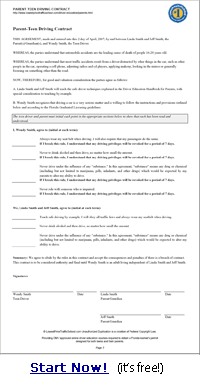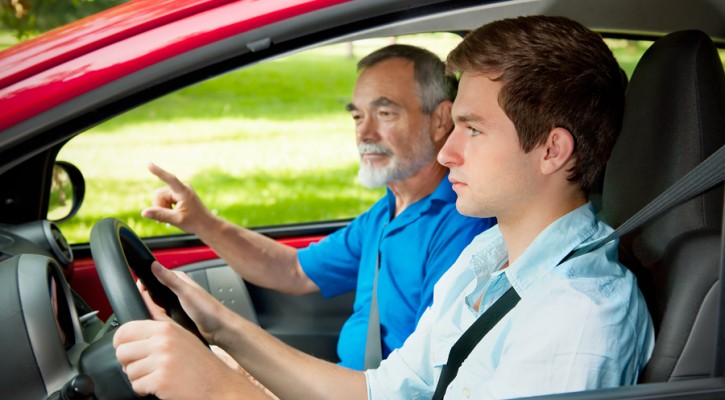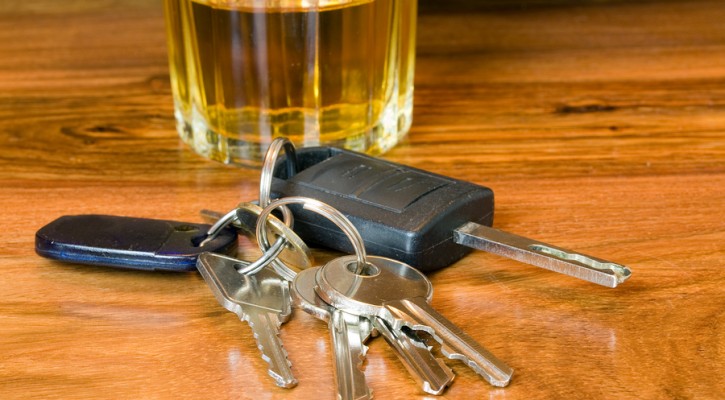Tag Archive: parent teen driving

How to Use a Teen Driving Contract
April 27, 2009
Teaching your teen to drive safely is one of your most important responsibilities as a parent, and training shouldn’t end when your teen gets a driver’s license.
The early years of driving are a dangerous time for teens. Almost 40% of all deaths for 16- to 19-year-olds occur in motor vehicle crashes; drivers in this age group are four times more likely to be involved in a crash than older drivers.
Setting and enforcing limits on your teen’s driving privileges will help keep your teen safe while reinforcing that driving is a serious matter. Be sure to set limits that comply with your state’s Graduated Driver’s Licensing laws. A Parent-Teen Driving Contract can help you ensure that your teen knows the rules in your household for getting and maintaining driving privileges and the penalties for breaking those rules.
Completing a Parent-Teen Driving Contract will be most effective if the concept and expectation are presented in advance (preferably at age 14). Make sure your teen understands that she or he will not be allowed to drive until an agreement is reached and both parties have signed the contract and initialed each term presented in it. Start a dialogue early about what the terms might include. Set aside at least thirty minutes to review the contract together before you and your teen sign it. Post the contract in a conspicuous place in your home so you and your teen can review it frequently.

How to Use a Teen Driving Checklist
April 14, 2009
Teaching their teen to drive is a stressful experience for many parents. The parent is nervous about the teen driver’s safety, while the teen is giddy with excitement. Parents may be ambivalent about this rite of passage because it means their child is growing up, while teens are eager for the new level of freedom and independence associated with a driver’s license. The parent wants the teen to absorb as much information about the driver training process as possible; the teen just wants to learn enough to pass the road test.
One way to manage driver training sessions is to use a Teen Driving Checklist. The checklist provides an opportunity to review concepts and provide feedback on the driving lesson. Using this tool provides structure to each lesson, which facilitates learning for the teen and helps the parent feel more comfortable about the process of teaching the teen to drive.
The parent should complete one copy of the checklist during each lesson. Before the parents share it with the teen at the end of the lesson, the teen can complete a second copy of the evaluation. This self-evaluation helps teens learn to assess the driving behavior of themselves and other drivers, a critical concept once they are out on the road on their own. After the teen finishes the self-assessment, the two checklists should be compared and discussed in detail.
Parents should be sure to acknowledge areas of improvement as well as make a note of skills that need further discussion and practice. If the driving lesson was particularly difficult, parents can wait a few hours to have the discussion, but it should take place prior to the next driving lesson so the teen won’t continue to practice bad habits.
Since the checklist includes basic, intermediate, and advanced skills, parents can easily tailor each driving lesson to a specific set of skills. Avoid packing too much into one driving lesson, which could overwhelm the teen driver. It is better to hold a few extra lessons than to take a chance on skimping on a teen driver’s knowledge of critical driving skills.

Alcohol Access and Your Teen – Trust but Verify
March 5, 2009
Your teenage daughter is spending the night at her friend Mary’s house. Mary’s mother seems to be a responsible, law-abiding adult. You’ve met her several times and there is no reason for you to think anything would go wrong. Mary’s dad is involved in charitable organizations. Still, you hesitate – but then think, why not?
The sleepover at Mary’s house seems perfectly innocent. Your daughter and her friend get good grades in school. They haven’t given you any real reason not to trust them. They are good kids. You’ve had the “choices equal consequences” talk with your daughter. And you have to trust your teen sometime, right? You have to let go.
You are trying to be reasonable.
For many parents, this is where the conflict begins. It’s difficult to decide when to hold back and when to let go. But you can’t let your guard down, because teenagers are vulnerable to temptation and peer pressure every day. What happens when…?
Mary’s parents are busy fulfilling their social and community obligations and aren’t paying attention to what your daughter and Mary are doing. They aren’t home, or they have friends visiting, or they are just weary from work, and their guard is down. Or perhaps they wear rose-colored glasses when it comes to Mary and believe that close supervision of the girls isn’t necessary because she would never betray their trust.
The teens head out to a party at John’s house. Maybe they said they were going to the movies, bowling, or just to hang out with John. John’s dad is a “cool” parent. He understands teenagers, likes to have people around and wants to know what goes on with his kids. John’s dad is an involved parent. He is teaching his son to be responsible. He wants John to drink in moderation and to be a responsible drinker. He reasons that John is going to drink alcohol anyway, so why not teach him how to do it responsibly?
So John’s dad buys beer for the party. Not too much, and he sets limits, cautioning John that each teen should have no more than two beers. He stays home to monitor the situation. Everything seems to be going just fine.
But John’s father didn’t consider the following:
- Early alcohol use, independent of other risk factors, strongly predicts the development of alcohol dependence.
- Of all people who ever meet the diagnostic criteria for alcohol dependence in their lifetime, nearly half do so by age 21 and two-thirds by age 25.
- People who reported starting to drink before the age of 15 were four times more likely to also report meeting the criteria for alcohol dependence at some point in their lives (National Institute on Alcohol Abuse and Alcoholism, 2009).
- Compared to youth who wait until they are 21, youth who drink before age 15 are 12 times more likely to be unintentionally injured while under the influence of alcohol, seven times more likely to be in a motor vehicle crash after drinking, and 10 times more likely to get in a physical fight after drinking (National Research Council and Institute of Medicine, 2004).
- Due to differences between the adult brain and the brain of the maturing adolescent, many young drinkers:
- Are able to consume much larger amounts of alcohol than adults before experiencing the negative consequences of drinking, such as drowsiness, lack of coordination, and withdrawal/hangover effects.
- Are particularly sensitive to the positive effects of drinking, such as feeling more at ease in social situations; young people may drink more than adults because of these positive social experiences (NIAAA, 2009).
- Recent evidence suggests adolescent drinking can inflict permanent damage on the developing brain (National Research Council and Institute of Medicine, 2004).These statistics do not take into account the risk that John’s dad is taking; in many states, he can be held criminally liable for providing alcohol to minors on property he owns, leases, or otherwise controls. Civil liability is always an issue; no state makes it legal for an adult to serve alcohol to someone else’s children. But if you aren’t vigilant, a tragedy could occur before you are even aware of the danger your child faces.Strengthen your resolve. Be your teen’s parent, not a friend. Make sure your teen understands that other adults can’t give them permission to drink alcohol. You’ve already said no, and no one else’s parent can overrule you.
Talk to, and listen to, your teen. Maintain an ongoing, open dialogue about underage drinking and the risks involved. Create a code word so that if your teen needs to be picked up early, you’ll do so with no questions asked until the following day, when you are both calm enough to discuss the situation sensibly. Let your teen know that you will not approve any outing without sufficient notice so you can speak to the hosting parent first.
When your teen spends the night at a friend’s house or goes to a party, call the hosting parent to find out the details. Volunteer to chaperone and provide transportation. Make sure the hosting parent shares your concerns about the availability of alcohol and that none will be permitted. Ask how much supervision will be provided.
Limit the amount of time your teen is away from home. Make sure you are awake and alert when the teen returns. Greet your teen with a kiss and a hug so you can observe your child’s physical, mental, and emotional condition.
It’s tempting for parents to relax their vigilance once their children become teenagers. After all, the teens will soon be on their own and beyond their parents’ control. But the teen years are a critical part of your children’s development, and the decisions they make could affect the rest of their lives. This is not the time to let down your guard.

Teaching Your Teen to Drive
February 3, 2009
Teaching your teen to drive is an exciting and highly anticipated rite of passage that means greater independence lies ahead. It may also be a time of mixed emotions. Many parents look forward to the day when they won’t be their teen’s main source of transportation, but they may also feel anxious about how safe their teen will be behind the wheel.
A plan of action will reduce the anxiety you feel about teaching your teen to drive. There are several actions you can take before you even allow your teen behind the wheel.
New drivers copy driving behaviors they have witnessed for years as passengers. Since they have probably ridden most often with parents, those behaviors are the ones they will imitate. To some parents, this is a somewhat frightening prospect. To make matters worse, teens who integrate risky driving practices into their own behavior do so without the benefit of years of experience and highly developed skills. Before you begin teaching your teen to drive, consider your own driving habits and make a commitment to correct any careless or reckless behavior and model good defensive driving practices consistently.
Another important aspect of teaching new drivers is good communication. Teens tune out lectures, so parents should work on developing a conversational rapport about safe driving with their children. Try to be concise; avoid going off on tangents. Ask for your teen’s opinion on hazards in your driving environment. For example, if you see children playing near the street, ask your teen to explain the risks and how to handle them. You can fill in details garnered from your own experience after your teen has a chance to be heard. Although it’s important to talk about driving risks, avoid horror stories. Instead, look for driving-related newspaper articles or subscribe to the National Safety Commission’s Safe Driving Teen Monthly Bulletin and discuss the articles together.
To help your teen understand more about the costs and responsibility of driving, review your insurance policy together, visit your insurance company’s website together, or pay a joint visit to your insurance agent’s office. Explain, or ask your agent to explain, the purpose of motor vehicle insurance. Discuss the cost of insurance and how the cost of your policy might increase or decrease. Ask your insurance agent whether a driver education course will result in a discount. Find out how much your insurance premium will increase after a single ticket or crash.
For many parents, driving is such an ingrained habit that they must refresh their knowledge about fundamental driving concepts. Doing so can only help you to be a better driving instructor to your teen, which in turn will help your teen be a better, safer driver.

Five Worst Teen Driving Mistakes: Part Two
December 19, 2008
Most parents live in dread of the day their teens get driver’s licenses and get behind the wheel on their own. Their concerns are well-founded, since teen drivers have the highest death rates in car crashes of any age group. Motor vehicle crashes are the number one cause of death among Americans aged 15-20. But parents can help their teens be a safer driver even after they are licensed, particularly by paying attention to common risk factors. In this five-part series, we’ll discuss the five worst teen driving mistakes:
- They don’t wear safety belts.
- They drink and drive.
- They panic/overcorrect in emergency situations.
- They drive too fast for conditions.
- They ride with other teens.
In this, part two of the series, we’ll discuss the risk teens take by driving after drinking alcohol. Teens are at far greater risk of death in an alcohol-related crash than the overall population, despite the fact they cannot legally purchase or publicly possess alcohol in any state. (National Highway Traffic Safety Administration)
Did you know?
- During 2006, 7,643 15- to 20-year-old drivers and motorcycle operators were involved in fatal traffic crashes across the nation, 1,377 (18 percent) of whom had a blood alcohol concentration (BAC) of .08 or higher.
- Nationally, 64 percent of all drivers or motorcycle operators ages 15 to 20 who were involved in fatal traffic crashes and had a BAC of .08 or higher died as a result of the crash.
- Violators of underage drinking laws often face a trip to jail, the loss of their driver’s license, and dozens of other unanticipated expenses including attorney fees, court costs, and other fines. Plus, there is the added embarrassment, humiliation, and potential loss and consequence related to academic eligibility, college acceptance, scholarship awards, and more.
- Most of those killed in alcohol-related crashes involving teen drivers are the young drivers themselves and their passengers.
All states now enforce a minimum drinking age of 21. Nevertheless, alcohol related crashes are still a top safety problem. Make sure your teen understands:
- Alcohol is not actually digested; it’s processed. It’s absorbed directly through the lining of the stomach into the bloodstream. This is why the body feels the effect so quickly.
- Alcohol has its first and greatest effect on the parts of the brain that control judgment and reasoning, the most critical skills needed by drivers. Physical abilities become impaired soon after.
- As more alcohol enters the bloodstream, the area of the brain that controls muscular movements and body control begins to slow down. Even after the driver recognizes danger, the brain takes longer than normal to process the information and react to the danger. Messages the brain sends to different parts of the body might become confused.
- A driver affected by alcohol has a decreased ability to reason clearly and to make sound judgments. However, the driver may feel as though thinking and judging abilities are sharper and quicker than usual.
- Alcohol quickly diminishes the ability to concentrate. A decrease in the ability to concentrate greatly increases a driver’s level of risk. A person’s driving ability can be reduced after only one drink.
- The muscular reactions of a driver who has been drinking can become slow and clumsy. Steering and braking movements can become uncoordinated. The driver might over-steer, brake late or not brake at all. The driver might not be able to negotiate turns properly and safely. Such actions cause drinking drivers to be involved in serious crashes.
Make sure your teen knows that she or he can always call you for a ride, whether the teen is intoxicated or is faced with the prospect of riding with a driver who has been drinking. Make a pact in which you promise to pick up your teen without questions or lectures. You can have a discussion about the issue the following day, when you are calmer and your teen is safe at home.
